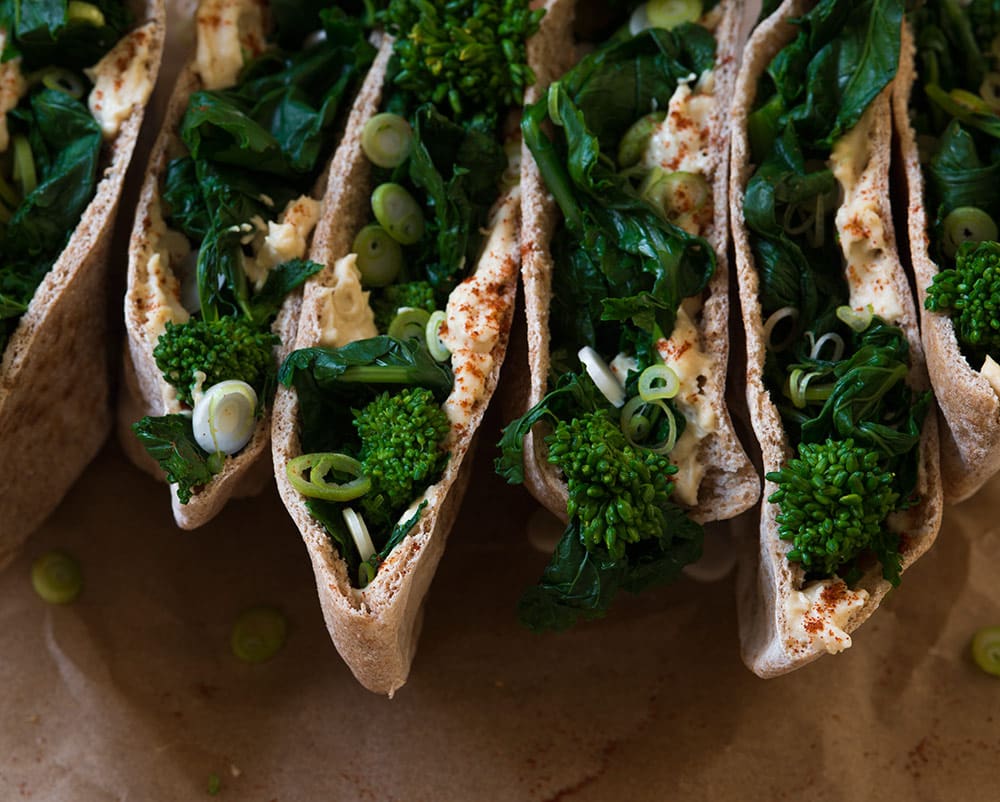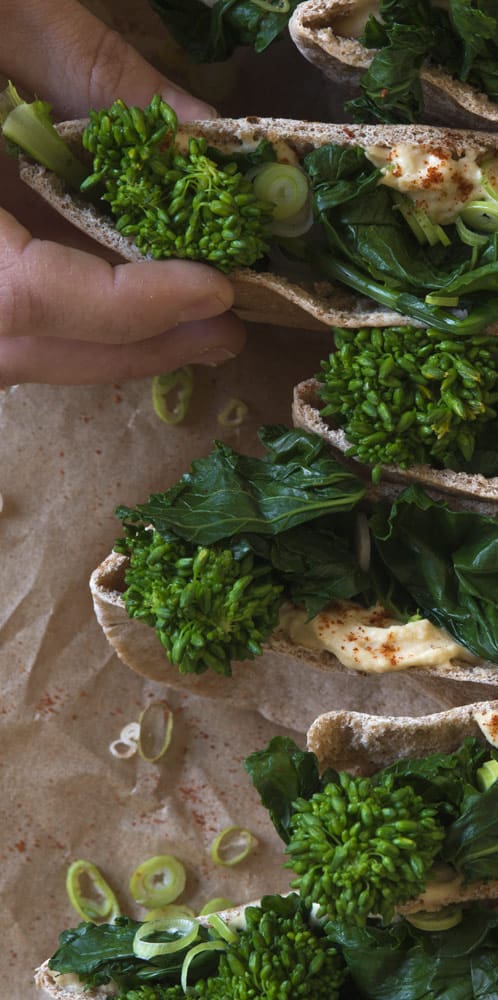Pita Pockets with Broccoli Rabe and Hummus
Beans or chickpeas are famously paired with greens in Mediterranean cooking for highly nutritious and tasty dishes whether for main courses or snacks. Include this nutritious and delicious duo in a packed lunch for your kids—just combine protein-packed hummus (chickpea spread) and heart-healthy broccoli rabe in a pita pocket for a quick and easy sandwich. Season it with smoky Spanish paprika, called pimentón, or if you prefer, spike the hummus with cayenne or another hot pepper.
Recipe by Julia della Croce
Julia is one of America’s foremost authorities on Italian cooking. She is a James Beard Award winning author and has written over 15 cookbooks.
Ingredients
Pita Pockets
- 6 individual fresh pita bread pockets
- 1/2 pint home-made (see our recipe below) or purchased unflavored hummus
- Smoked Spanish paprika (pimentón)
- 3/4 pound (half bunch) cooked broccoli rabe, well drained and patted dry
Homemade Hummus (yields 1 pint):
- 4 ounces (about 1 cup dry weight) dried chickpeas
- 1 small onion, peeled and quartered
- 2 medium clove garlic, minced or passed through a garlic press
- 1/4 cup tahini
- 1 teaspoon fine sea sea salt
- Freshly squeezed juice of 1 medium organic lemon
- Ground cumin, hot paprika, or sumac for sprinkling
- Extra-virgin olive oil for drizzling
Directions: Pita Pockets
1. Spread hummus on the inside of the bread pocket. Season with the pimentón.
2. Stuff the greens into the pocket. Close the pocket. Serve at once, or wrap well for a portable lunch.
VARIATION: Add a layer of finely sliced, raw scallion to the filling.
COOK’S TIP: The broccoli rabe can be prepared up to a day in advance.
Directions: Homemade Hummus
1. Two days before you plan to make the hummus, pour the chickpeas into a bowl and pick them over carefully for any stones. Cover them in water and agitate them to shake out any impurities. Transfer them to a sieve and rinse them well in cold water.
2. Transfer the chickpeas to a bowl and add 4-5 inches of cold water to cover. Do not add salt until after the chickpeas are cooked. Soak overnight at room temperature, or chilled. Drain and rinse them and return them to the bowl with fresh cold water. Soak for another day. Drain and rinse them again.
3. Place the soaked chickpeas in an ample pot with the onion and four inches of cold water to cover. Bring to a boil and reduce to medium heat. Simmer for 1 hour, partially covered, skimming off any foam or loosened skins that float to the water surface. If it starts to dry out, add more water as needed. Drain and rinse the chickpeas and return them to the pot. Continue to cook them as before, until they are soft and mushy, another hour or so.
4. Use a strainer or skimmer to lift out the chickpeas. Transfer them to a bowl and reserve the cooking water. If you would like a velvety hummus, slip off and discard their skins. For a slightly grainier texture, leave the skins on.
5. Set aside a small handful of the chickpeas to garnish the hummus later. Transfer the rest of them to a food processor with 1/4 cup of the reserved cooking water and the garlic. Engage the motor and blend well until smooth. Add the tahini, salt, and lemon juice. Blend until the hummus is light and almost fluffy, adding a little more cooking water if it is too thick. Taste for seasoning.
6. Transfer the hummus to a shallow serving bowl. Scatter the reserved whole chickpeas on the surface and sprinkle with the cumin, hot paprika, or sumac. Add a thread of the olive oil on top.
Get the scoop on Broccoli Rabe: recipes, health benefits, & nutrition information. Learn more
Click below to view nutrition information.
• View Nutrition Facts •





